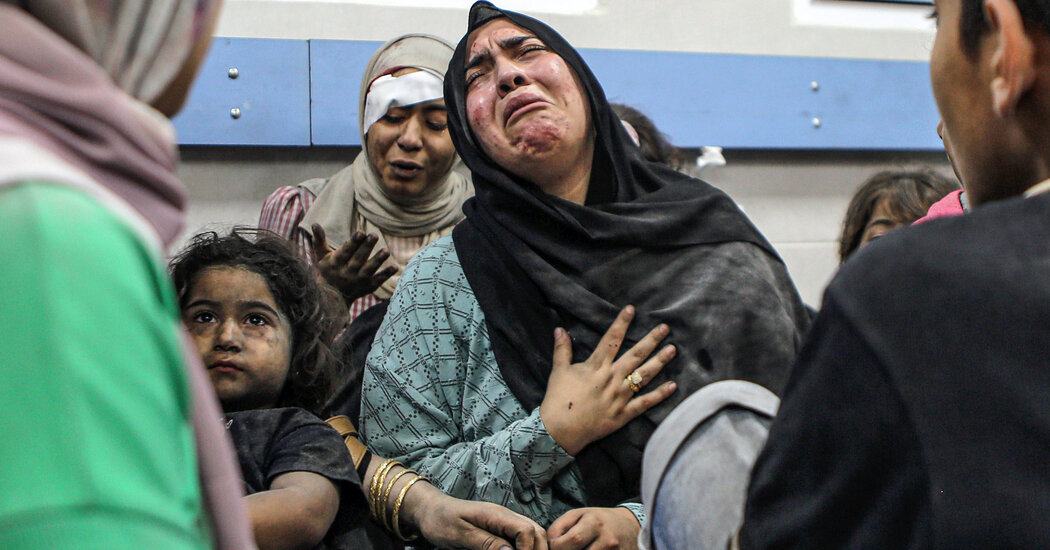Maui Fire Death Toll, at 89, Is Highest in U.S. in a Century
LAHAINA, Hawaii — The death toll in the firestorm that decimated the Maui town of Lahaina reached 89 on Saturday, the authorities said, making it the deadliest wildfire in the United States in more than a century.
The toll seemed likely to rise further in the coming days. Chief John Pelletier of the Maui County Police Department said that only 3 percent of areas burned on Tuesday had been searched by canine teams. He urged people with family members who were missing to be swabbed for DNA. More cadaver dogs were on the way, he said.
The death toll surpassed that of the 2018 Camp Fire in California and marked the deadliest wildfire since a blaze in northeast Minnesota killed hundreds of people in 1918.
Although the fires were extinguished in western Maui, the area was far from calm. The authorities reversed themselves and closed off entry to residents looking to return.
“It is not safe,” Mayor Richard T. Bissen Jr. of Maui County said of downtown Lahaina. Access was closed because people had entered areas where authorities needed to search for possible human remains, officials said.
Many residents who fled on Tuesday were struggling to find gasoline, water and other essentials. An informal network of volunteers created an impromptu aid delivery system that one participant called the “Coconut Underground.” Some questioned why they had to rely on friends and private organizations for help rather than on government agencies.
“It’s an incredible dichotomy,” said Paul Romero, the owner of a gym in Kihei, southeast of Lahaina, who led several supply runs into the area. “There is an outpouring of local support, boots on the ground, depleting our personal resources to support our Ohana in just the most basic ways,” he said, using a Hawaiian word for family and close friends.
State and federal officials said that more help, in the form of National Guard members and Federal Emergency Management Agency workers, was on the way.
Questions also swirled on Saturday over whether some loss of life could have been averted.
Residents who survived the fire questioned why no one had activated any of the 80 warning sirens around Maui, which emit noises at a higher decibel level than that of a loud rock concert and can be heard more than half a mile away. Hawaii boasts what it describes as the largest system of outdoor public safety warning sirens in the world.
The Hawaii Emergency Management Agency’s spokesman, Adam Weintraub, confirmed the sirens had not been activated. They alone would not have been a sign to evacuate but for residents to seek more information, he added.
Mr. Weintraub said that other alert systems were activated — including alerts sent to cellphones and through radio and television stations — but the power was out for much of Tuesday in Lahaina, and many residents said they never received any warnings.
No cause for the fire has been determined, but experts said one likely possibility was that active power lines that fell in high winds ignited the wildfire that ultimately spread to Lahaina.
Scrutiny grew over Hawaiian Electric, the state’s largest utility and the parent company of the power provider on Maui. As wildfires on Maui have grown in size in recent years, some residents have urged the power company and state regulators to help prevent electrical equipment from making things worse.
But Hawaiian Electric made wildfire prevention its lowest priority in a state regulatory filing in April.
“There should have been a requirement for them to cut off power,” said Jennifer Potter, a former member of the Hawaii Public Utilities Commission. She said she had fielded numerous calls from residents on Maui, long before this week’s fire, about the need for a stronger wildfire prevention strategy. “Wildfire mitigation has taken a back seat in utility planning,” she said.
After the major fires of 2017 and 2018 in California, the authorities there mandated power cuts at times of heightened fire danger. No such action was taken in Maui despite the increasingly frequent wildfires.
Jim Kelly, a spokesman for Hawaiian Electric, said that the utility did not have a shut-off program. Shutting off the power, he noted, would have also cut the electricity that powers pumps needed to supply water to fire hydrants for firefighting.
Gov. Josh Green said Friday that he had authorized a review of the emergency response, and Hawaii’s attorney general, Anne Lopez, said her department would conduct a “comprehensive review” of decisions made before and after the fires.
Those able to return to Lahaina before police closed off the main road sifted through the rubble of their homes Friday and Saturday for prized possessions — watches, pieces of jewelry, anything that may have been spared in the conflagration.
In a measure of the devastation, FEMA said Saturday that the cost to rebuild after the Lahaina fire would be around $5.52 billion. The agency estimated that at least 2,200 structures were damaged or destroyed — nearly 1,500 of them residential — and that more than 2,100 acres were burned.
Some 4,500 households on the island, even if their homes were untouched by fire, remained without power Saturday afternoon. The Maui County authorities issued an advisory that residents of Lahaina should not drink the tap water, which they said might be contaminated with benzene and other dangerous chemicals.
Even as search crews searched for remains in the gutted neighborhoods of Lahaina, there was a sense that Maui was not out of danger.
A fire flared on Friday night in the Kaanapali area, a few miles north of Lahaina, dangerously close to a fueling station that was preparing to distribute 3,500 gallons to motorists. The fire was contained, but officials suspended the distribution of fuel on Saturday.
The resorts and towns north of Lahaina, like Napili and Kapalua, were not burned in last week’s fire. But residents were still without power Saturday. Some evacuees from Lahaina who were staying in the area got stranded without gas for their cars, according to Juan Trevizo, the associate pastor at Citizen Church in Napili, which was distributing food and supplies.
Harrowing tales continued to emerge of the escape from the flames in Lahaina.
Lisa Francis, 54, a Hawaii native who has lived in Lahaina for 31 years, was trying to drive home from her job at a bank in town Tuesday evening when the firestorm caught up to her.
Stuck in traffic, she escaped toward the ocean, taking refuge on the strip of rocks along the water.
As the fire roared through the cars and buildings on the street above, unleashing a choking wall of thick smoke, she clung tightly to a large boulder on the edge of the water. Embers left her sleeveless arms with mosquito-bite-size burns. Her eyes were seared by smoke and stung by saltwater. Hours later, she and others climbed back up the rocks and sat against the sea wall.
Help arrived at 1 a.m. on Wednesday, and she found herself on a truck barreling down a charred landscape.
“Everything — scorched,” she said. “I felt like I was in a place I had never been before.”
For others, the agonizing wait to hear from loved ones missing since the fire continued. Jason Musgrove has been trying to locate his 69-year-old mother, Linda Vaikeli, since Tuesday.
Ms. Vaikeli, a resident of Lahaina since 1997, has not responded to texts, and her phone goes straight to voice mail.
“Just not knowing makes me feel gutted inside,” said Mr. Musgrove, 50, who lives north of Houston and is flying to Maui on Sunday to help track down his mother, who needs the assistance of a wheelchair.
“The hope is that she made it out of the apartment.”
Gaya Gupta, Serge F. Kovaleski, Orlando Mayorquin and Mitch Smith contributed reporting.


